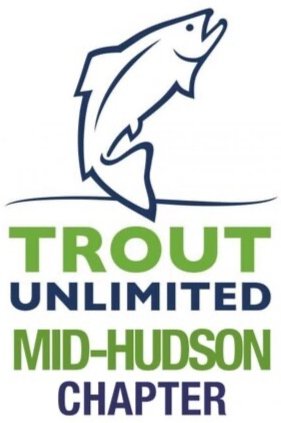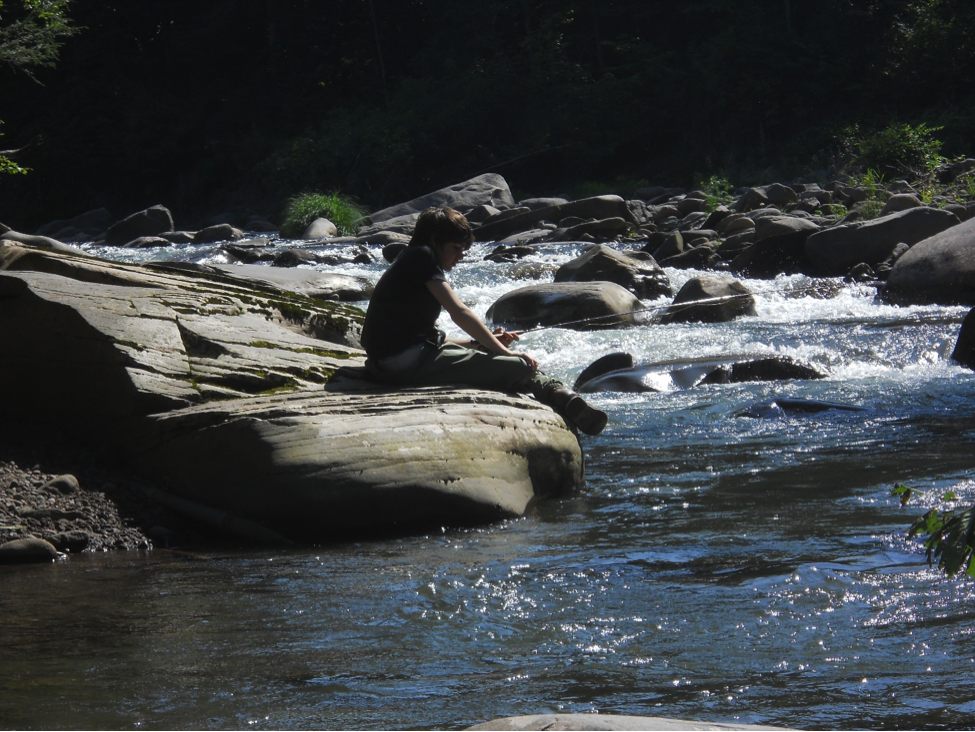NYMPHING
Dan Swart
Mid-Hudson Trout Unlimited
NYMPHING
What: Fishing below the surface
Why: Trout feed under the surface 90%of the time
When: All the time, even during hatches
Where: Mainly in riffles and runs, also heads and tails of pools
How: Sinking flies beneath the surface using special leader set-ups and line
Nymph fisherman must posses a range of tactics that present the fly at various depth allow the natural actions to be mimicked
EQUIPMENT
RODS: 8-9ft 5wt rods generally the best. 10’+ rods used in ‘tight line’ tactic
REELS: Just holds the line
LINE: Floating W/F is the norm. Sinking tip line used in special situations where line has to sink fast
LEADERS: Delivers the last of the energy of that casts the fly over the water. Affects the way the fly moves and how fast it sinks.
Many different styles, single fly rigs, multiple fly rings, use of tippet rings to adjust the tippet length.
LINE CONTROL
Most important aspect of fly fishing!
There is no time to think of what your hands are doing while you are concentrating on watching your line and leader for strikes.
Casting, mending, and line handling techniques are used to constantly manage the unnecessary slack in the line.
Practice your mending and holding the line under your finger until it becomes automatic.
No more slack in the line than can be taken up by lifting the tip of the rod to set the hook
TIGHT LINE NYMPHING
Heavy rig lobbed upstream with only 2-3 ft of flyline out past the tip guide to maintain a tight connection between rod tip and fly.
Hold the rod level and move it downstream ahead of the fly to control drag and keep line tight.
Slowing, stopping or change in direction indicates a strike.
Use of fluorescent leader butt sections helps in seeing the take on the water.
LEISENRING LIFT
Leisenring lift used with caddis pupae cast upstream and allowed to drift downstream with current.
Raising and lowering the rod while following the fly downstream to control the slack in the line.
As the fly passes downstream lower the rod allowing the fly to drift downstream as far as it can go then lift the rod and line smoothly
to lift the fly off the bottom and sweep it to the surface. This imitates the fly emerging and will likely provoke a very hard strike
from the trout.
TUCK CAST
Joe Humphreys developed the ‘tuck cast’ to get the fly to the bottom as fast as possible and keep it there throughout the drift.
Basic tuck cast is done while casting upstream stopping the rod abruptly at the 10:30 position.
The flyline will snap back allowing the fly to tuck under ad drop into the water first and sink to the bottom before the
drag of the water has a chance to lift the fly up off the bottom.
There are many versions of the tuck cast, down & under, rolling tuck cast, tuck & mend cast that were developed by Joe Humphreys.
SHOTGUN CAST
Developed by Gary Borger in which you position yourself below the trout (downstream) and randomly cast into the riffles above
them.
You control the line by stripping it in as it gets closer to you.
Allowing the fly to drift out you can ‘flip’ the line back up into the riffles.
Repeat this until you have covered all the feeding areas.
NYMPHS
Stone flies: Large insects that crawl along the bottom in highly oxygenated water. Crawls to shore or large rocks to hatch. They will
migrate to shore in large numbers to hatch, trout notice this and will feed on them close to shore.
Caddis pupae: Unlike stone flies and mayflies caddis have a pupal stage. They form cases around themselves made of small grains of
sand and vegetation. Trout will eat them case and all. They prefer riffles, rapids, and fast run. Sometimes they loose their footing
and get swept into the current where they are easy prey for the trout. Leisenring lift is an excellent was to fish these nymphs.
Mayflies: Multiple types. Crawlers, clingers, burrowers and swimmers. Some nymphs cling to the bottom of the rocks and feed on
whatever food passes by. Only when they are knocked loose and into the current are they available to the trout. Crawlers around on
the bottom to feed and are regularly available to the trout. Burrowers dig into the soft mud and gravel on the bottom of pools
and feed on whatever passes by their openings. Swimmers (isonychia) are predators and feed on other aquatic insects and small
minnows. Can move very fast and is larger than most of the other mayflies. Will crawl to the shore to hatch on the rocks like the
stonefly.
LEADER SETUPS
TIPPET LENGTH SHOULD BE CALCULATED AS 1½ X ESTIMATED WATER DEPTH
Strike indicator: 71/2 ft leader with 30-inch tippet using a fly that sinks to the bottom.
To adjust the depth of the fly, slide the strike indicator up or down the leader butt.
If using an unweighted fly, you can attach a split shot sinker just above the fly.
If you put the sinker next to the fly it will stay on the bottom, by moving the sinker away from the fly it will drift above the bottom.
A buoyant dry fly can be used as a strike indicator by attaching tippet to the hook and trailing the nymph behind.
Adjust the depth by shortening or lengthening the piece of tippet.
Can use two nymphs in the same manner, bottom fly should be weighted, strike indicator above the top fly.
Adjust the depth by sliding the indicator up and down the leader, for example, a weighted stone fly nymph on the bottom and a
pheasant tail above it drifting in the current.
POCKET WATER
Tight line tactic is best used because of changes in current speed, direction and depth occur quickly and keeping the least amount of
slack in the line is best to detect strikes. Set your hook at the slightest tug or if the leader stops, pauses or changes direction.
RIFFLES & RUNS
Strike indicator nymphing is best. Although current may be fast, speed and direction are consistent. Strike indicator will allow you to
see the strike and set the hook quickly.
Slightest pause or change in direction you should set the hook. Strikes can be really subtile and close attention to the line and
indicator is important.
POOLS
Slow water, not a lot of nymphs live here, mainly midge larvae, pupae and burrowing type. Some pools have faster currents that
allow nymphs to drift through on their way downstream. Best fishing is at the head or tail of the pool.
HEAD OF POOL
This is where the current goes from fast to slow and drops food off like a conveyor belt.
Trout will hang out in their feeding lie waiting for the nymphs to drop into the slow water where it’s easier to catch them.
The idea is to stand downstream of the trout (behind them) and cast into the riffles above the slow water and let the fly drift down.
Be mindful of the movement of your rod and line passing over the trout, try not to spook them.
Line control is essential here, you must strip in line as the fly comes closer to you keeping the slack out of the line.
Allow the fly to drift down into the pool, away from the fish before ‘flipping’ the line upstream into the riffles.
By using the ‘shotgun’ method you repeat this by casting randomly above the riffles until all the feeding areas are covered.
TAIL OF POOL
This is where the water flows out of the pool back into the stream. The current speeds up and gets shallower, concentrating the food
into a much smaller water column for the trout to feed in. By casting above the tail, you can drift your fly down into the faster
water where the trout are feeding.
Posted: 1/9/21





